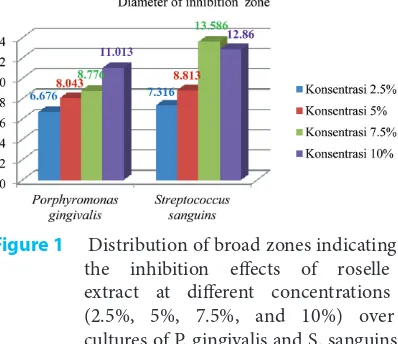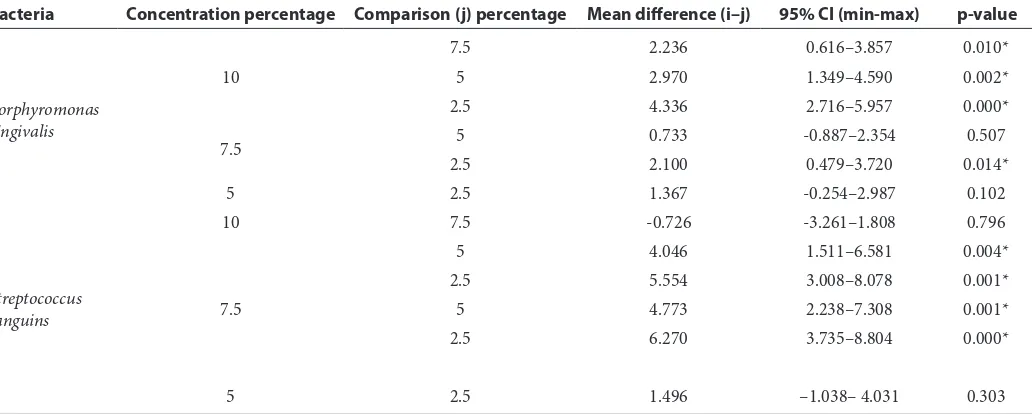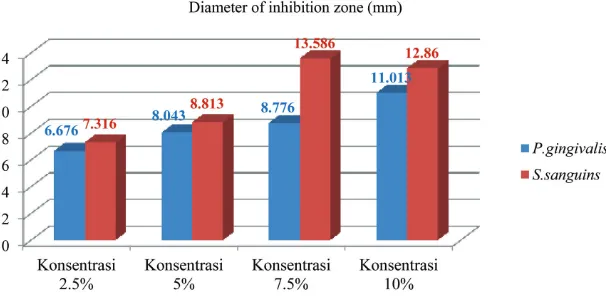P-ISSN.2503-0817, E-ISSN.2503-0825
CrossMark
Abstract
Objective:The purpose of this study is to evaluate the roselle ethanol extract against P. gingivalisbacteria (gram-negative bacteria) and S. sanguis (gram-positive bacteria).
Material and Methods:This in vitrostudy evaluates the antibacterial effectiveness of roselle (hibiscus sabdariffa L.) ethanol extract on P. gingivalis and S. sanguis. Natrium agar (NA) solution was poured into a glass plate which had previously been sterilized and then left in place until the medium solidified. P. gingivalis and S. sanguis bacterial cultures were inoculated. Then these were put on a paper disk which had previously been saturated with roselle extract samples at a concentration of 2.5%, 5%, 7.5% and 10%. Negative control at the surface of the medium (ampicillin) and incubated for 1 day. A clear zone that was formed was then observed and measured.
Results: Showed that for roselle flower extract used with 2.5% concentration of 2.5%, there are wide differences in the inhibition zone of 0.640 mm between the two bacteria, where broad zones of greater inhibition belonged to S. sanguins. However, results of statistical tests showed wide differences between bacterial inhibition zones of P. gingivalis and S.sanguins created with the use of roselle flower extract at 2.5% concentration are not significant. The other significant differences are shown for concentrations at 5% and 10%. Meanwhile, at a concentration of 7.5%, there were wide differences in the inhibition zone at 4.810 mm between the two bacteria. Conclusion:That the ethanol extract of roselle flowers can effectively inhibit gram-positive and gram-negative bacteria.
Keywords:Roselle etanol extract, S. sanguis, P. gingivalis, Antimicrobial activity
Cite this Article:Indriani L, Dharmautama M. 2016. Antimicrobial test of Roselle (Hibiscus sabdariffa L.) ethanol extract againts Porphyromonas gingivalis and Streptococcus sanguisusing agar method (In vitro study). Journal of Dentomaxillofacial Science 1(2): 127-131. DOI:10.15562/jdmfs. v1i2.12
Antimicrobial test of roselle (hibiscus sabdariffa l.)
ethanol extract againts porphyromonas gingivalis
and streptococcus sanguis using agar method
(in vitro study)
Lenni Indriani,1*Mochamad Dharmautama2
Introduction
Use of natural materials has been increasingly steadily over the years in many fields of health-care, including in dentistry. A key advantage of using natural ingredients is that the side effects are minimal and they are safe for the body. One of the natural plants used in drinks, food and medicine is hibiscus sabdariffa linn, commonly known as roselle. Roselle has more than 300 species distrib-uted in tropical and non-tropical regions. Most of the Roselle plant is used for ornamental purposes and some are believed to have medical properties, one of which is red or roselle (hibiscus sabdariffa L).1,2
The bacteria’s increased resistance to antibiot-ics led the extensive research and development of innovations in creating more powerful antimicro-bial agents. Some potential sources of plants have been studied because they contain many bioactive components that can be utilized in therapy and has a low toxicity inside it making them highly useful in the treatment of infectious diseases.3
Porphyromonas gingivalis (P. gingivalis) is a gram-negative bacterium found in oral areas and can cause periodontitis. Chronic periodontitis has complex etiology and inflammatory disease is caused by an infection in the endemic pathogens of the intraoral biofilms. Several major gram-neg-ative bacteria are closely related to periodontal infections such as P. gingivalis, tannerella forsythia and treponema denticola. Dental plaque bacteria in chronic gingivitis consists of 56% of species of gram-positive, 44% of gram-negative bacteria and 59% of species are facultative and 41% are anaerobic. The dominant species of gram-positive bacteria include S. sanguis, S. mitis, S. intermedius, S. oralis, Actinomyces viscosus and Actinomyces naeslundi.
Therefore, the purpose of this study is to test the inhibitory effects of roselle extract at a concentra-tion of 2.5%, 5%, 7.5% and 10% against P. gingivalis bacteria (gram-negative bacteria) and S. sanguis (gram-positive bacteria).
1Department of Dental Materials, Faculty of Dentistry, Hasanuddin University, Makassar, Indonesia 2Department of Prostodontic, Faculty of Dentistry, Hasanuddin University, Makassar, Indonesia
*Correspondence to: Lenni Indriani, Department of Dental Materials
lenni_601@yahoo.co.id
Material and Methods
The present research is based on a laboratory exper-imental research design with post-test activities, only to control the design of group. This research was conducted in the Laboratory of Microbiology Faculty of Pharmacy Hasanuddin University, Makassar, Indonesia.
Roselle extract
Identification of roselle flower petals was conducted to determine the identity of the crude drug to be used prior to the study. Then dried roselle flower petals weighing as much as 400 g were powdered to be used as a crude drug. As much as 100 g of powder was extracted by maceration using 1 L of fluid filters with 70% ethanol and placed in a glass
container/jar for further screening. After three days, a mixture of dregs plus ethanol measuring as much as 1.125 L was stirred and placed in a closed vessel for two days. From the filtrate, dregs and sediments were separated using a filter paper and filtrate I and II were mixed and put into a vacuum rotary evaporator to obtain a thick extract that was to be used for further observations two days later.
Antimicrobial test
The antimicrobial test was performed on the media under the following procedures: Nutrient broth (NB) 0.4 g was dissolved in 50 ml of distilled water and then the solution was put into a test tube and sterilized in an autoclave. NA mixture (mixture of NB 0.8 g and 2 g) was dissolved in 100 ml of distilled water and the resulting solution was heated or boiled changing NA solution’s color to translucent yellow. NA solution was poured into a glass plate which had previously been sterilized and left in place until the medium solidified. P.gingivalis and S. sanguis bacterial cultures were inoculated and then solidified. Then these were put on a paper disk which had previously been saturated with Roselle extract samples with concentrations of 2.5%, 5%, 7.5% and 10%. The negative control was kept on the surface of the medium (ampicillin) and incubated for 1 day. A clear zone was formed and was then measured.
Results
Test results showing inhibitory characteristics of roselle flower the effect of roselle flower extract at concentrations of 2.5%, 5%, 7.5% and 10% over P. gingivalis and S. sanguis cultures can be seen below. There were 24 samples (12 samples of P. gingiva-lis and 12 samples of S. sanguins) that were treated with roselle flower extract in four different concen-trations to determine the broad zone of inhibition (mm). The observations are shown in table 1 and
figure 1. It can be seen that the largest zone of inhibi-tion occurred with roselle extract at a concentrainhibi-tion of 2.5%, compared to other concentration levels for both bacteria, that is S. sanguins and P. gingivalis.
Meanwhile, the average increase in the broad zones of inhibition of bacteria P. gingivalis occurred at 10% of the extract concentration, making it the largest broad zone of inhibition (10%, that is 11.013 mm). However, the bacteria S. sanguins shows that the vast zone of greatest inhibition was found with an extract concentration of 7.5% and not with a concentration of 10%, that is 586 mm table 1 and
figure 1.
Table 2 shows the results of different test averages for broad zones of inhibition (mm) of
Table 1 The Average Differences between Broad Zones of Inhibition (mm) Bacteria P. gingivalis and S. sanguins at Various Concentrations of 2.5%, 5%, 7.5% and 10% Roselle Flower Extract
Bacteria concentration (%)Roselle extract n (%)
Power zone of inhibition size (mm)
p-value
Mean ± SD
Porphyromonas gingivalis
2.5 3 (25) 6.676 ± 0.496a
0.000*
5 3 (25) 8.043 ± 0.315a
7.5 3 (25) 8.776 ± 0.282a
10 3 (25) 11.013 ± 1.053a
Total 12 (100) 8.627 ± 1.723
Streptococcus sanguins
2.5 3 (25) 7.316 ± 0.900a
0.000*
5 3 (25) 8.813 ± 1.037a
7.5 3 (25) 13.586 ± 0.665a
10 3 (25) 12.860 ± 1.195a
Total 12 (100) 10.644 ± 2.884
Note: *One-way ANOVA test: significant at p<0.05.
extract concentrations at 2.5%, 5%, 7.5% and 10% over cultures of bacteria P. gingivalis and S. sanguins. There was a difference between the broad zones of inhibition measuring 4.336 mm for concentrations at 10% and 2.5%. The inhibition zone with the largest difference among all groups pertained to P. gingivalis bacteria. Furthermore, Tukey’s honestly significant difference (HSD) test yielded a p-value of 0.05, which means the vast difference between the zones of inhibition at 10% and 2.5% is a significant difference. Differences between broad zones of inhibition are shown in the comparison between the smallest concentrations at 7.5% and 5%, for a 0.733 mm-wide zone. Using different test results we arrived at p<0.05, which means the vast difference between the inhibition
zones created with the use of roselle flower extract at small concentrations of 7.5% and 5% is not significant for P. gingivalis.
Our study results showed there is a difference between broad zones of inhibition when we compared the effect of roselle extract used in two different concentrations at 7.5%, 2.5% and in this specific case the broad zones expanded to cover an area measuring as large as 6.270 mm. This difference is statistically significant. The smallest difference was found in a comparison between roselle extract used with 10% and 7.5% concentrations, which yield a difference of 0.726 mm between the broad zones created. Values presented in table 3 show the broad zones created with different concentrations ranging from minus 7.5% to a concentration greater than 10%. This shows
Table 2 Results of Further Different Test Averages of Broad Zones of Inhibition (mm) of Roselle Flower Extract Used
with Different Concentrations at 2.5%, 5%, 7.5% and 10% over the Bacterial Cultures of P. gingivalis and
S. sanguins
Bacteria Concentration percentage Comparison (j) percentage Mean difference (i–j) 95% CI (min-max) p-value
Porphyromonas gingivalis
10
7.5 2.236 0.616–3.857 0.010*
5 2.970 1.349–4.590 0.002*
2.5 4.336 2.716–5.957 0.000*
7.5 5 0.733 -0.887–2.354 0.507
2.5 2.100 0.479–3.720 0.014*
5 2.5 1.367 -0.254–2.987 0.102
Streptococcus sanguins
10 7.5 -0.726 -3.261–1.808 0.796
5 4.046 1.511–6.581 0.004*
2.5 5.554 3.008–8.078 0.001*
7.5 5 4.773 2.238–7.308 0.001*
2.5 6.270 3.735–8.804 0.000*
5 2.5 1.496 –1.038– 4.031 0.303
Note: *post hoc test: Tukey’s honestly significant difference (HSD) test: significant at p < 0.05.
Table 3 Average Difference between the Broad Zones of Inhibition of Bacteria P. gingivalis and S. sanguins for Different Concentrations, at 2.5%, 5%, 7.5% and 10%, of Roselle Flower Extract
Roselle extract concentration (%)
Bacteria
Diameter of inhibition
zone (mm) 95% CI
(min-max) p-value
Mean ± SD
2.5 P. gingivalis 6.676 ± 0.496 –0.640 (–2.288–1.008) 0.342
S. sanguins 7.316 ± 0.900
5 P. gingivalis 8.043 ± 0.315 –0.770 (–2.507–0.967) 0.286
S. sanguins 8.813 ± 1.037
7.5 P. gingivalis 8.776 ± 0.282 4.810 (–5.969–3.650) 0.000*
S. sanguins 13.586 ± 0.665
10 P. gingivalis 11.013 ± 1.053 –1.846 (–4.401–0.708) 0.115
S. sanguins 12.860 ± 1.195
that roselle extract with a 7.5% concentration created extensive zones in bacteria S. sanguins.
Table 3 and figure 2 show the distribution and the average difference between the broad zones of inhibition of bacteria P. gingivalis and S. sanguins for roselle flower extract used with concentrations at 2.5%, 5%, 7.5% and 10%. Results showed that for roselle flower extract used with 2.5% concentration of 2.5%, there are wide differences in the inhibi-tion zone of 0.640 mm between the two bacteria, where broad zones of greater inhibition belonged to S. sanguins. However, results of statistical tests showed wide differences between bacterial inhibi-tion zones of P. gingivalis and S.sanguins created with the use of roselle flower extract at 2.5% concentration are not significant. The other signifi-cant differences are shown for concentrations at 5% and 10%. Meanwhile, at a concentration of 7.5%, there were wide differences in the inhibition zone at
4.810 mm between the two bacteria. This difference is the largest between S. sanguins and P. gingivalis, where the inhibition was bigger for S. sanguins than for P. gingivalis. Statistical test results also showed that there are wide significant differences in the inhibition zones of P. gingivalis and S. sanguins created with roselle flower extracted used with a concentration of 7.5%. Thus, roselle flower extract is more effective in inhibiting bacterial S. sanguis.
Discussion
Roselle is a one-year-old shrub, and it grows to reach a maximum height of 2.4 m. Stem is red, round in shape and hairy in appearance, alternate leaves grow up to 3–5 strands with a length of 7.5–12.5 cm, leaves are generally green, with reddish midrib and a short petiole.
Another study conducted by Komala et al.4
regarding the inhibition of roselle flower extract against S. pneumoniae found that phytochemical ethanol extract and water extract of roselle flower petals contain tannin, saponins and flavonoids. The effectiveness of the extracts is equally good in inhibiting the growth of S. pneumoniae bacteria and the higher the concentration of the extract, the greater its effectiveness. Minimum inhibitory concentrations were achieved even at a concentra-tion of 1% (from the mother liquor 70 g/100 ml).4
In this study, it was found that the inhibition of the ethanol extract of roselle flowers against P. gingiva-lis and S. sanguis demonstrated an average increase of broad zones of inhibition of bacteria P. gingivalis followed by increased concentrations of roselle flower extract, making it the largest broad zone
Figure 2 Distribution of broad zones of inhibitionP. gingivalisand S. sanguins based on different concentrations with which the Roselle flower extract was used
Figure 3 Zone of inhibition of S. sanguis
(11.013 mm). However, the bacteria S. sanguins shows that the vast zone of greatest inhibition was found at a concentration of 7.5%.
The results of this study indicate roselle flower extract is able to inhibit both gram-negative and gram-positive bacteria, that is, P. gingivalis and S. sanguis. The results of other studies are also consis-tent with the results of our study Mardi et al.5
roselle extract effectively inhibited the growth of bacteria and C. albicans. The roselle flower contains poly-phenols, according to some studies they can induce antibacterial activity by inhibiting the growth of bacteria S. sanguis that triggers the formation of dental plaque and gingivitis.6
This plant can reduce the proliferation of bacteria by blocking the enzyme in microbial metabolism. Phenol present in roselle has pharmacological properties, especially anti-inflammatory, antiviral and cytotoxic properties.7,8
Yuen et al.9
evaluated 20 different kinds of tradi-tional Chinese medicines against the four types of oral bacteria, S. mitis, S. mutans, S. sanguis, P. gingivalis and their results showed the traditional medicine of herbal rhizoma copitidis and galla chinesis were able to inhibit these four bacteria in vitro.9
Fullerton et al.10
conducted a study of the antimicrobial activity of H. sabdariffa in E. coli isolated from food, livestock and clinical samples by using a flower extract at concentrations of 2.5%, 5% and 10%. They found the phenols contained within H. sabdariffa effectively inhibited E. coli at concentrations of 2.5%, 5% and 10%.
Djeussi et al.3
results support the use of tradi-tional crops (adonsonia digitata aframomum alboviolaceum, hibiscus sabdariffa, aframomum polyanthum, anonidium manni, ocimum gratissi-mum, and tamarindus indica) in the treatment of
Results of the present study show that roselle flower extract with concentrations of 2.5%, 5%, 7.5% and 10% is able to provide inhibition against gram-pos-itive and gram-negative bacteria P. gingivalis and S. sanguis and the visible differences between broad zones of inhibition were significant in both bacteria used in the study.
Ethanol extract of Roselle effectively inhibits P. gingivalis, a gram-positive bacteria, when used with a 10% concentration and inhibits S. Sanguis, a gram-negative bacteria, when used with a 7.5% concentration. Overall it can be concluded that the ethanol extract of roselle flowers is effective in inhibiting both gram-positive and gram-negative bacteria. Furthermore, the results derived based on the study of the efficacy of ethanol extracted from roselle flower petals have a strong scope for applica-tion in the manufacture of gel concentraapplica-tion.
Conflict of Interest
The authors report no conflict of interest
References
1. Fitofarmaka. Referensi kesehatan. Roselle (hibiscus
sab-diffa L). Nanobiotechnol 2008;3: 541-546.
2. Da-Costa-Rocha I, Bonnlaender B, Sievers H, et al. A
phy-tochemical and pharmacological review. Food Chemistry 2014;165: 424-443.
3. Djeussi DE, Noumedem JAK, Seukep JA, et al. Antibacterial
activities of selected edible plants extracts against multi-drug-resistant gram-negatif bacteria. Complementary and Alternative Medicine 2013;13: 164.
4. Komala O, Rosyanti R, Muztabadihardja. The effectiveness
test of antibactery of roselle (hibiscus sabdariffa L.) sheath ethanol extract and water extract against streptococcus pneumonia. Berita Biologi; 2013.
5. Mardi SA, Dharmautama M. Pengaruh konsentrasi dan
lama perendaman gigitiruan lepasan akrilik dalam infusa bunga roselle terhadap penghambatan pertumbuhan bak-teri dan albicans. Reaserch report; 2013.
6. Suwandi T. Pengembangan potensi antibakteri kelopak
bunga hibiscus sabdarifa L (roselle) terhadap S. sanguis penginduksi gingivitis menuju obat herbal standar. FKG UI; 2012.
7. Pacome OA, Bernard DJYHN, Sekou D, et al.
Phytochemical and antioxidant activity of roselle (hibiscus sabdariffa L.) petal extracts. Research J Pharmaceutic Biological and Chemical Sci 2015.
8. Meraiyebu AB, Olaniyan OT, Eneze C, et al.
Anti-inflammatory activity of methanolic extract of hibiscus sabdariffa on carrageenan induced inflammation in wistar rat. Int J Pharmaceutical Sci Invention 2013;2: 22-24.
9. Yuen MKZ, Wong RWK, Hagg U, et al. Antimicrobial
activity of traditional chinese medicines on common oral bacteria. Chinese Medicine 2011: 37-42.
10. Fullerton M, Khatiwada J, Johnson JU, et al. Determination
of antimicrobial activity of sorrel (hibiscus sabdariffa) on escherichia coli isolated from food, veterinary and clinical samples. J M ed Food 2011;14: 950-956.


